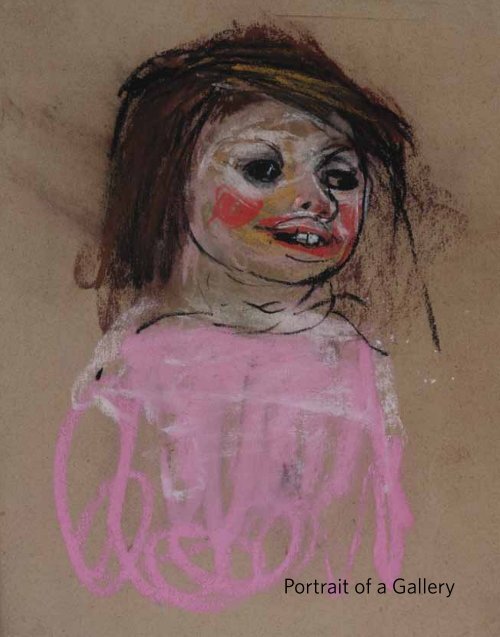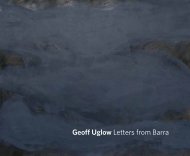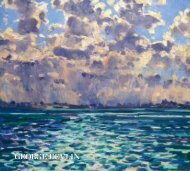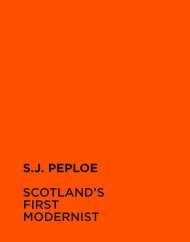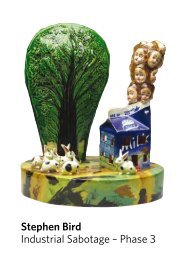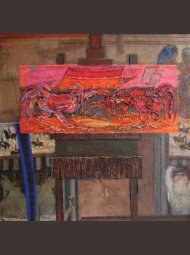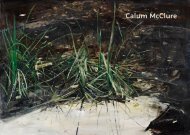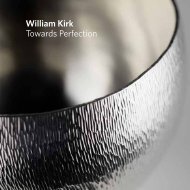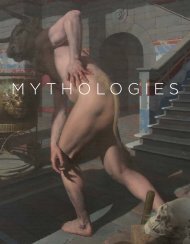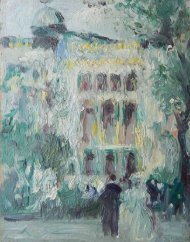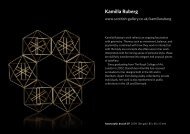Portrait of a Gallery - The Scottish Gallery
Portrait of a Gallery - The Scottish Gallery
Portrait of a Gallery - The Scottish Gallery
- No tags were found...
You also want an ePaper? Increase the reach of your titles
YUMPU automatically turns print PDFs into web optimized ePapers that Google loves.
<strong>Portrait</strong> <strong>of</strong> a <strong>Gallery</strong><strong>The</strong> influential magazine <strong>The</strong> Art Journalpublished an article in the spring <strong>of</strong> 1897under the headline ‘Art In Scotland.’ <strong>The</strong>piece welcomed a reorganisation withinthe National Galleries <strong>of</strong> Scotland allowingexhibitions for eight months a year <strong>of</strong> aselection from the RSA Diploma collection.This was seen as an important step,acknowledging the lack <strong>of</strong> representation <strong>of</strong><strong>Scottish</strong> work within the National Galleries<strong>of</strong> Scotland. <strong>The</strong> debate continues to this day.Of much greater significance in hindsightwas the announcement <strong>of</strong> the opening <strong>of</strong><strong>The</strong> <strong>Scottish</strong> <strong>Gallery</strong> in Edinburgh “…avowedlyand specially for the exhibition and sale <strong>of</strong>the works <strong>of</strong> <strong>Scottish</strong> painters. Messrs Dottand Co., the young partners in a house longhonourably known in the North, broughttogether in the past autumn a collection <strong>of</strong>200 excellent examples <strong>of</strong> the best artists inScotland and the reception the collection metinsures that it will be followed by others <strong>of</strong> thesame caliber.”<strong>The</strong> story began in May 1842 with thefounding <strong>of</strong> an art supply business by a mancalled Aitken Dott. <strong>The</strong> family had come fromCupar in Fife, from an artisanal background:Aitken Dott’s grandfather had worked as astonemason on the construction <strong>of</strong> EdinburghUniversity’s New College in 1789. Little isknown <strong>of</strong> his early life except the colourfuldetail recalled in a rare early letter <strong>of</strong> how thefifteen year old boy had witnessed the hanging<strong>of</strong> William Burke in the Grassmarket.Edinburgh was still a city <strong>of</strong> Enlightenmentin the 1840s, home to writers, philosophers,publishers and entrepreneurs and so notsurprisingly to painters able to train atthe Trustees Academy, develop a portraitpractice without the necessity <strong>of</strong> moving toLondon and exhibit their work in the Royal<strong>Scottish</strong> Academy, founded in 1826. Artistsbegan to exhibit independently <strong>of</strong> theirpatrons and require galleries and exhibitionsin which to display their paintings for sale.To begin with Dott provided art materials andframing services to this growing community,advertising the firm as ’Gilders, Framers andArtists Colourmen’. <strong>The</strong> business thrived andin 1860 Dott moved from South St David’sStreet to 26 South Castle Street, the addressthe firm would occupy for the next 120 years.<strong>The</strong> move provided better shop premises,workshops, and the space to show work forsale. Dott had already established workingrelationships with many <strong>of</strong> the successfulpainters <strong>of</strong> the day, even answering the callfor cash advances from the landscape painterHoratio McCulloch sending letters from theGairloch Inn in Dingwall where he was trying t<strong>of</strong>inish two landscapes and had run out money.When his son Peter McOmish Dott wrote theintroduction to William McTaggart’s exhibition<strong>of</strong> 1907 he celebrated fifty years <strong>of</strong> associationbetween artist and gallery. It was the son whotook the business to the next stage with theopening <strong>of</strong> <strong>The</strong> <strong>Scottish</strong> <strong>Gallery</strong> in 1896 and theinstitution <strong>of</strong> regular one-person exhibitions<strong>of</strong> new painters. <strong>The</strong> gallery was still only onepart <strong>of</strong> a larger business and the partners hadoptions about how to use it: for SJ Peploe’sfirst one-person show in 1903 the gallery wasrented to the artist who was responsible forall the cost and arrangements in return for asmall (10%) commission. In 1907, perhapsrecognising the need to modernise, McOmishDott took on a younger partner, GeorgeProudfoot and they together undertook a majorrefurbishment <strong>of</strong> the premises creating thesplendid first-floor galleries at no. 26.3
It was a time <strong>of</strong> transition in manyways; a generation <strong>of</strong> landscape and genrepainters, mostly senior Academicians, hadbeen represented by the gallery and providedthe heart <strong>of</strong> the picture dealing part <strong>of</strong>the business. But by 1910 younger artists,trained in Paris, were demanding attentionas the inspiration <strong>of</strong> post-Impressionismworked its way through the institutions andconsciousness <strong>of</strong> the art establishmentand public.<strong>The</strong> change in Scotland is best illustratedby <strong>The</strong> <strong>Scottish</strong> <strong>Gallery</strong>’s relationship withSamuel John Peploe (1871-1935). As wehave noted he had his first show in 1903,comprising impressionist landscapes, stilllives and figure compositions painted in afluid manner which recalls both Whistlerand Manet. <strong>The</strong> show was a success andhe showed again in 1909, in a similar veinthough he now pushed the limits <strong>of</strong> this earlytechnical mastery in interiors with his newmodel Peggy McRae. But the show was alsosomething <strong>of</strong> a clear out; he had decided tomove to Paris, partly at the urging <strong>of</strong> his friendJohn Duncan Fergusson; the winds <strong>of</strong> changewere upon him and within two years he sawhis earlier work with a sort <strong>of</strong> disdain; brilliantbut limited. <strong>The</strong> work he brought back to showMcOmish Dott in 1911 horrified the seniorpartner; brilliantly coloured panels <strong>of</strong> Royanand Brittany and the Paris parks and a fewstill lives in a Van Gogh style. Initially rejectedby the gallery, Peploe was to show more inLondon with the Baillie and Stafford Galleriesin these years. In Edinburgh he put on hisown show in the New Galleries in ShandwickPlace, home <strong>of</strong> the artist-run Society <strong>of</strong> Eight.Dott retired shortly afterwards and GeorgeProudfoot quietly mended the fences, buyingwork during the war years and pushing for ajoint contract with Reid and Lefèvre that led toone-man-shows in 1922, 1925, 1927 and 1930.<strong>The</strong> other passion <strong>of</strong> Proudfoot was thework <strong>of</strong> a generation <strong>of</strong> brilliant British etcherswhose popularity in the 20s constituted agolden age for the medium. Seymour Hayden,Edmund Blampied, the Swede Anders Zornand the Scots DY Cameron, James McBeyand Muirhead Bone figured most prominently.<strong>The</strong> public rooms <strong>of</strong> the shipping line ownerMajor Ion Harrison’s home in Helensburghwas sumptuously hung with the work <strong>of</strong>Peploe, Hunter and Cadell but the stairs werefull <strong>of</strong> the latest, sought after prints by thesemasters. <strong>The</strong> print department, at variousstages encompassing master reproductions,etchings and an antiquarian department, wasa feature <strong>of</strong> the gallery up until the 1980s.In more recent times when an artist, likeElizabeth Blackadder or Victoria Crowe hasmade printmaking a significant part <strong>of</strong> theircreative output, the gallery will recognisethis with exhibitions. In addition there havebeen significant exhibitions <strong>of</strong> individualmajor printmakers such as the first HowardHodgkin show in Scotland at the art fair heldat Edinburgh College <strong>of</strong> Art in 1985. At thesame event Robert Fraser, recently reopenedin Cork Street, brought the American graffitiartist Jean-Michel Basquiat (who came intothe gallery and bought some pencils andwhose auction record from 2007 now standsat $14.2m). <strong>The</strong> event, organised by RichardDemarco (and titled Demarcations!), waspoorly attended and sadly within three yearsboth Fraser and Basquiat had died.In the post-war decades the galleryfostered the careers <strong>of</strong> the painters wh<strong>of</strong>ormed the Edinburgh School, and inparticular William Gillies. Gillies died in1973 and by then the gallery had sold wellover 1,000 works for him, more than half tothe collector Robert Lillie the pick <strong>of</strong> whosecollection eventually went to <strong>The</strong> <strong>Scottish</strong>National <strong>Gallery</strong> <strong>of</strong> Modern Art. In this sensea significant portion <strong>of</strong> the modern collectionwas acquired indirectly through <strong>The</strong> <strong>Scottish</strong><strong>Gallery</strong> and many other inspired purchases<strong>of</strong> work by artists as diverse as William Gear,Robin Philipson and Rory McEwan came intothe National Collection from the gallery.As well as Gillies the career <strong>of</strong> Philipson, hissuccessor as Head <strong>of</strong> the Painting School,blossomed under the guidance <strong>of</strong> BillMacaulay, the gentle academic who steeredthe business through the confusions <strong>of</strong> the60s and 70s. By the 80s Bill Jackson wasat the helm and had moved the gallery to94 George Street; Guy Peploe joined himin late 1983. It was an exciting decade forpainting that saw the emergence <strong>of</strong> the NewGlasgow group including the prodigioustalents <strong>of</strong> Stephen Conroy and Alison Wattwho had her first major solo show in thegallery’s short lived London premises in 1990.<strong>The</strong>re were major shows <strong>of</strong> new work duringthe Edinburgh Festival for John Bellany in1985, Bruce McLean (including a performancewhich took place at <strong>The</strong> Fruitmarket <strong>Gallery</strong>)in 1986 and important survey exhibitionsexploring the theme <strong>of</strong> modernism in<strong>Scottish</strong> painting.<strong>The</strong> gallery finally moved from CastleStreet in 1981; a short move to 94 GeorgeStreet, premises with a narrow Victorian shop4 5
front and a splendid gallery behind under awide rectangular cupola. <strong>The</strong> shop was initiallyoccupied with artist’s materials in a franchisearrangement with Millers Graphics but beforelong an award-winning conversion wascommissioned to accommodate an exhibitionprogramme for objects. This was not out<strong>of</strong> the blue; the gallery had always shownobjects including Cartier jewellery in 1914.When an artist like Jessie M King decoratedpots or Anne Redpath painted furniture orAlan Davie designed jewellery the galleryexhibited the work. In the post-war decadesthe gallery reflected the fruitful relationshipbetween artist and manufacture showing theceramics <strong>of</strong> Paolozzi and then Bruce McLean.Henry Rothschild <strong>of</strong> the Primavera <strong>Gallery</strong>put on two brilliant survey exhibitions <strong>of</strong>British and European studio pottery, includingLucie Rie and Hans Coper, and many makerswere represented in our regular summer andChristmas exhibitions. But the commitmentwas now substantial and Amanda Game wasrecruited in 1987 to take the policy forward.<strong>The</strong> touring exhibition Shape and Surface,curated by Joan Crossley-Holland <strong>of</strong> theformer Oxford <strong>Gallery</strong>, included work by manymajor figures who are still represented today,including the jewellers Wendy Ramshawand Jacqueline Mina and ceramics by AlanCaiger Smith, Gordon Baldwin, Sutton Taylorand Takeshi Yasuda. Today the departmentalnature <strong>of</strong> the business has subsided in favour<strong>of</strong> a more integrated approach, under theguidance <strong>of</strong> Christina Jansen, to incorporatedesign, the decorative and fine arts. Ourcommitment to the very best <strong>of</strong> internationalObjects is undimmed and is prosecutedboth in the gallery in Dundas Street, with ourmany ground-breaking and career-formingexhibitions, and in the preeminent position weenjoy at Collect in London every May, wherea roster <strong>of</strong> museums queue up to buy work.<strong>The</strong> 90s were substantially a time <strong>of</strong>consolidation after the recession <strong>of</strong> 1990which briefly threatened the future <strong>of</strong>the gallery as we disposed <strong>of</strong> our Londonbusiness. It was a time that also saw therebuilding <strong>of</strong> relationships with senior <strong>Scottish</strong>painters such as John Houston, ElizabethBlackadder and David Michie, the emergence<strong>of</strong> Barbara Rae as a great colourist andthe late flowering <strong>of</strong> the career <strong>of</strong> AlbertoMorrocco. <strong>The</strong> gallery became a consistentand successful exhibitor in the two mostimportant London art fairs; in Islington andthe Royal College where we were able toextend the market and reputation <strong>of</strong> ourgallery artists. Quality in art is not subject t<strong>of</strong>ashionable shifts beyond the vicissitudes <strong>of</strong>the marketplace (which as market insiderswe seek to exploit in any case) and it is to thiswe cleave in all our planning. In this we have atreasure trove for a history and are delightedto rediscover artists from our past, rekindleand celebrate many <strong>of</strong> the trade relationshipswe have enjoyed before and highlight some <strong>of</strong>the stories which lend colour and humanity tothe process <strong>of</strong> display and sale which is stillthe business <strong>of</strong> <strong>The</strong> <strong>Scottish</strong> <strong>Gallery</strong>.It is firm gallery policy to look at any workpresented to us for consideration. If we stoplooking the whole process will grind to a halt.In any year <strong>of</strong> our programme there shouldbe artists new to us. Some will be recentgraduates others might have served a longerapprenticeship and have lived and workedfurther afield. We are not a gallery which hasa narrowly defined exhibition policy preferringto be the broad church which has been thecharacter <strong>of</strong> the many golden eras through ourlong history.In this short publication we are celebratinga long and diverse history and tell some <strong>of</strong>the stories which help illuminate all the artwe have displayed and sold over the decades.We cannot attempt to include everything andso must issue a blanket apology for all theomissions, <strong>of</strong> which there are far more thaninclusions; after all for us the most importantshow is the next one so we have at leasttried to present an element <strong>of</strong> a preview <strong>of</strong>forthcoming shows. Perhaps there will bean opportunity to publish a comprehensivehistory and definitive reference book beforetoo long. Instead we have sought to includesome surprises and reminders <strong>of</strong> work notassociated with us today. Our history reflectsthe taste <strong>of</strong> dozens <strong>of</strong> men and women whohave worked here, some for too long, somefor not long enough! Like our brilliant artistsour dedicated staff has, and will continue to,guarantee more wonderful art and reasons tolove <strong>The</strong> <strong>Scottish</strong> <strong>Gallery</strong>.Guy PeploeManaging Director6 7
A Landscape TraditionThree artists perhaps need to be singledout for the parts they played in establishingthe iconography and characteristics <strong>of</strong> whatmost people would recognise as archetypal<strong>Scottish</strong> landscapes. In 1840, two years beforethe founding <strong>of</strong> Aitken Dott’s business, theman described by the great Sir David Wilkieas the “founder <strong>of</strong> the landscape school <strong>of</strong>Scotland”, Alexander Nasmyth, died aged 82.He is particularly noted for his large panoramic<strong>Scottish</strong> landscapes and townscapescharacterised by topographical correctness andattention to detail. Initially these have a strongsense <strong>of</strong> the picturesque following works seenon an extended trip to Italy in the 1780s. Laterhis work changed possibly under the influence<strong>of</strong> Dutch landscapes and a broader, moreatmospheric approach is also evident. In thelate 1780s he opened a school for landscapepainting in Edinburgh which placed greatemphasis on drawing trips to promote directobservation <strong>of</strong> the natural landscape.In the same year another importantbut younger figure also died. <strong>The</strong> Rev JohnThomson <strong>of</strong> Duddingston had indeedtaken some lessons from Nasmyth butwas largely self-taught and developed intoa painter <strong>of</strong> free brushwork and dramaticcompositions, Highland Scotland seen as aplace <strong>of</strong> wildness <strong>of</strong> nature <strong>of</strong>ten punctuatedwith built reminders <strong>of</strong> its turbulent history.Thomson was a true Romantic in his approachto painting and it is certain that no smallinfluence was his long-term friendship withnovelist and poet Sir Walter Scott, that greatpromoter <strong>of</strong> the romance <strong>of</strong> <strong>Scottish</strong> historyand <strong>of</strong> national identity. Scott’s atmosphericdescriptions <strong>of</strong> the <strong>Scottish</strong> landscape usedfor poetic or narrative effect surely findparallels in Thomson’s own heightened sense<strong>of</strong> the dramatic.Horatio McCulloch (1805-1867) was, aswe have seen, very much an Aitken Dott’sartist and perhaps more than any other,helped create the 19th century image <strong>of</strong> the<strong>Scottish</strong> Highlands. His work is based onmany painting trips to the Highlands, Skye andthe Western Isles during which he producedlively watercolours and oil sketches whichwere later worked up into larger freely paintedworks in the studio. His hugely popularportrayal <strong>of</strong> the <strong>Scottish</strong> landscape wasfurther disseminated through the many widelyavailable engravings made after his paintings.Our first really comprehensive salesrecords date from the inaugural <strong>Scottish</strong><strong>Gallery</strong> exhibition in 1896 in the new CastleStreet premises, in which works were shownby a range <strong>of</strong> well-established and youngerartists, much as the gallery does today.Included were William McTaggart, HughCameron, WD McKay, Lawton Wingate,Robert McGregor and Robert Noble andworks by Glasgow painters, includingAlexander Roche, J Morris Henderson andArchibald Kaye, as well as representativesfrom Kirkcudbright (WS McGeorge andBessie McNicol) many <strong>of</strong> whom had shownwith us previously and would continue to doin the future. Furthermore, the inclusion <strong>of</strong>works by deceased artists like Sam Bough andHoratio McCulloch reveals the continuation<strong>of</strong> the well established practice <strong>of</strong> dealing inearlier works sourced from auction rooms,other dealers and private clients.William McTaggart RSA, RSW (1835-1910)<strong>The</strong> Preaching <strong>of</strong> St Columba 1895 oil on canvas 51 x 63.5 cms signed and datedProvenanceLindsay Collection, Dundee; DM Jackson, Edinburgh; RW WalkerExhibitedAitken Dott and Son, William McTaggart Exhibition, 1907Manchester City Art <strong>Gallery</strong>, William McTaggart Exhibition, 1937, catalogue no.2.One <strong>of</strong> Scotland’s most famous landscape painters, William McTaggart’s paintings are typified by loose,energetic brushwork and a deep concern for the effects <strong>of</strong> light. <strong>The</strong> <strong>Scottish</strong> <strong>Gallery</strong> were McTaggart’smain dealer in his lifetime, selling many <strong>of</strong> his greatest works to the likes <strong>of</strong> Robert Wemyss Honeymanand Andrew Carnegie. <strong>The</strong> gallery were such great advocates <strong>of</strong> McTaggart’s paintings that SJ Peploecomplained <strong>of</strong> having his paintings “crammed down my throat”.<strong>The</strong> Preaching <strong>of</strong> St Columba was exhibited at <strong>The</strong> <strong>Scottish</strong> <strong>Gallery</strong> in 1907: a major exhibition thatmarked an association <strong>of</strong> 50 years between artist and gallery.8 9
Arthur Melville RP, ARSA, RSW, RWS (1855-1904)<strong>The</strong> Sapphire Sea 1892 watercolour 78 x 50.5 cms signed, dated and inscribed, ‘Passages’ 92’ProvenanceCaleb MargerisonExhibited<strong>The</strong> Grafton <strong>Gallery</strong>, London, 1893; <strong>The</strong> Royal Institute <strong>of</strong> Watercolours, Arthur Melville MemorialExhibition, London 1906, catalogue no. 81; <strong>The</strong> Royal Glasgow Institute <strong>of</strong> Fine Arts, 1907, catalogueno. 7. <strong>The</strong> picture is currently hanging in Pioneering Painting: <strong>The</strong> Glasgow Boys 1880-1900 at Kelvingrove Art<strong>Gallery</strong> and Museum which then goes to the Royal Academy <strong>of</strong> Arts, London.Melville who was rightly regarded as the most brilliant watercolourists <strong>of</strong> his period, developed a stunningand idiosyncratic technique. He attended the RSA schools and from 1878 studied in Paris where he wasimpressed by the work <strong>of</strong> French Realist painters and the Barbizon School. Associated with the GlasgowBoys he was however a restless traveller and soon moved from their <strong>Scottish</strong> urban and pastoral subjectsto more exotic fare from Egypt, Persia and Spain attracted by strong light, brilliant colours, the drama <strong>of</strong> thebullfight or the bustle <strong>of</strong> an eastern harbour.Often he worked wet into wet to allow colours to blend, sometimes sponging out areas particularly insome <strong>of</strong> his bullfight pictures to suggest the visual bleaching effect <strong>of</strong> dazzling sunshine. He would thenwork with assured smaller strokes over dried areas.<strong>The</strong> Sapphire Sea is very much about large masses <strong>of</strong> colours, the eponymous blue being dominant butbalanced by blocks <strong>of</strong> green in the hills and the browns and terracottas <strong>of</strong> the ro<strong>of</strong>s. Sparking highlights<strong>of</strong> white in the boats and parasols, <strong>of</strong> the tiny figures and small dramatic punctuations <strong>of</strong> their shadows,sunshades and windows enliven the work.Our records show that in 1888, the year before he moved to Surrey we sold for the artist severalimportant watercolours including a Spanish Landscape, two Venetian works, Sirocco and Garnet Sails andKing Cophetua which is probably the work currently in the collection <strong>of</strong> the National <strong>Gallery</strong> <strong>of</strong> Scotland.10 11
<strong>The</strong> <strong>Scottish</strong> ColouristsToday, for many, Peploe, Fergusson, Hunterand Cadell, known as <strong>The</strong> Colourists, representthe greatest achievements in <strong>Scottish</strong> painting.<strong>The</strong>ir work can be properly seen in a Europeancontext and they were the first <strong>Scottish</strong>painters to see themselves as modern.Today a tradition <strong>of</strong> belle peinture persistsin <strong>Scottish</strong> painting, some <strong>of</strong> it withoutthe rigour and ambition still so powerfullyapparent in the best work <strong>of</strong> the Colourists.Perhaps more importantly their example:dedicated, single-minded and outwith theestablishment, helped succeeding generationsmake their way in a new atomized art world,full <strong>of</strong> possibility. <strong>The</strong> <strong>Scottish</strong> <strong>Gallery</strong> washome to the ideas, exhibitions and the lives<strong>of</strong> <strong>The</strong> <strong>Scottish</strong> Colourists. So important arethey to our business that we have created adedicated area within our website in which tohouse their work.SJ Peploe had several exhibitions in 1912,but not in Edinburgh. Peploe seemed to PeterDott a lost cause, his new work was tooradical for the dealer to accept and his oneman show was cancelled. In a letter fromMargaret Peploe to Stanley Cursiter shewrote: ‘Mr Dott was still somewhat concernedabout Sam’s “changes”. He was afraid aboutthe influence life in Paris, “French Art”, mighthave on him and on his art. He wrote me avery kind letter, full <strong>of</strong> advice: my husbandwas an Artist, one <strong>of</strong> the few: “<strong>The</strong>re was aresponsibility, a duty,” he made me feelboth very keenly. Poor Mr Dott. I’m afraidthere was another shock coming to him.’However, the shock mustn’t have been toogreat for the gallery as Peploe went on tohave successful shows with us throughoutthe 20s and early 30s ending with a Memorialshow in 1936.<strong>The</strong> <strong>Scottish</strong> <strong>Gallery</strong> is going to bringtogether many <strong>of</strong> these rejected ‘modern’paintings for the first time in a specialcentenary exhibition in 2012.George Leslie Hunter (1879-1931)<strong>The</strong> Seine and the Pont Neuf c.1925 oil on board 37.5 x 45 cms<strong>The</strong> Pont Neuf is a misnomer since it is the oldest bridge in Paris. It spans the western end <strong>of</strong> the Île de laCité and Hunter depicts its most famous aspect looking upstream towards the left bank, law courts anddistant spires. This brilliant oil painting similar to Marseilles illustrated in Honeyman’s Introducing LeslieHunter has a thick impasto built up into an uneven texture across which he can pull pigment to createeffects in the sky and water. His palette is bright: acid greens, yellow and cool blues, the architecture givenstructure with decisive drawing with his brush in black.12 13
SJ Peploe RSA (1871-1935)Jeanie Blyth c.1900 pastel 26.25 x 18.75 cmsJeanie Blyth was one <strong>of</strong> Peploe’s first models. She sold flowers on Shandwick Place near to where Peploehad his studio in the Albert Buildings from around 1896. In this early period he made many chalk drawingson tinted paper, occasionally with a wash and they display a dexterity and economy <strong>of</strong> drawing whichis characteristic <strong>of</strong> all his work with crayon, conté or brush. He painted her twice with a smile but in thissimmering work the look is a slow burn <strong>of</strong> dawning sexuality.<strong>The</strong> first work that <strong>The</strong> <strong>Scottish</strong> <strong>Gallery</strong> sold for the artist, in March 1897, was a drawing titled GypsyQueen and would certainly have been <strong>of</strong> the same sitter.SJ Peploe RSA (1871-1935)Trees at Douglas Hall c.1915 signed lower right oil on board 40.5 x 32 cmsDouglas Hall is on the Galloway coast near Dalbeattie where Peploe visited whilst painting and working inKirkcudbright. <strong>The</strong> thick impasto, bold outlines and high colouring is Peploe at his most daring.14 15
George Leslie Hunter (1879-1931)Street Scene c.1920 pastel and ink 26.5 x 20.5 cmsHunter produced much more on paper in the last ten years <strong>of</strong> his life than in oil. He was leading aperipatetic life moving from the South <strong>of</strong> France to London and Scotland in search <strong>of</strong> inspiration and thepracticalities favoured drawing and watercolour. He was supported by his friend Tom Honeyman, then apartner in Reid and Lefèvre, but who was more than once disappointed to receive a package <strong>of</strong> works onpaper for a planned exhibition <strong>of</strong> new work. But these vigorous and spontaneous drawings with crayon orwatercolour are some <strong>of</strong> the most vivid, successful works <strong>of</strong> the artist’s maturity. <strong>The</strong> nervous energyin his marks are not obscured by overwork and the excitement the artist feels at work is communicated.He worked in Nice, Villefranche and here in the Antibes. This is perhaps one <strong>of</strong> the works entrusted toWilly and Denis Peploe for delivery to Lefèvre in London on their way returning to School at the end <strong>of</strong>the summer holidays from Cassis in 1924.J D Fergusson RBA (1874-1961)Luxembourg Gardens, Evening c.1906 signed and inscribed with title and date versooil on panel 18 x 23 cmsProvenanceT and R Annan; Ewan Mundy Fine Art; Private Collection, ConnecticutIt is evening in Montparnasse and couples take the passeo around the pond in the Luxembourg Gardens.Fergusson has not yet moved to Paris but is certainly making plans; he is to move late in 1907 into a studioapartment in the Blvd. Edgar Quinet and his work is soon to undergo a dramatic transformation.This small panel shows how he has reached the perfection <strong>of</strong> his early technique. He uses a creamy,enamel-like paint and prefers immensely subtle tonal compositions, enlivened by a few jewel-like strongercolour notes. <strong>The</strong> brush strokes are long and confident: Whistler and Sargent are perhaps his strongestinfluences but he is an artist <strong>of</strong> great confidence about to launch himself on Paris and embrace all themodern influences in the melting-pot <strong>of</strong> European culture from a position <strong>of</strong> confidence.16 17
FCB Cadell RSA, RSW (1883-1937)Still Life, Blue and White c.1912 signed lower left and inscribed with title verso oil on board 37 x 45 cmsProvenanceDuncan R Miller; Private Collection, ConnecticutCadell’s early work in oil is very different in character from the early period Peploe and Fergusson. <strong>The</strong> twosenior painters who worked together and shared their ideas and to some extent, used a rich, creamy vehiclefor their pigment which owed more to 17th Century Dutch painting and early Manet than to Impressionism.Cadell’s work before 1914 is very dashing, freely painted and favours a palette dominated by white butusing yellow, orange and blues in high key.In our picture, the composition is lit from the left or rather suffused in an afternoon light, making theshadows half-tones and the highlights on the blue and white china gleam s<strong>of</strong>tly. A framed silhouette hangson the wall and a half-peeled lemon completes the colour scheme.J D Fergusson RBA (1874-1961)Effulgence c.1923 brass sculpture 21.5 h x 13 x 13 cmsFergusson, held his first one man show in Scotland at <strong>The</strong> <strong>Scottish</strong> <strong>Gallery</strong> in June 1923, exhibiting nineteenpaintings and six sculptures. Fergusson was influenced by African art via the general interest by otherartists such as Picasso and Brancusi. Of all the Colourists, Fergusson was the one that viewed the worldthrough the sculptor’s eye.18 19
<strong>The</strong> Edinburgh SchoolIn the post 1945 years a significant group <strong>of</strong>painters who began to show on a regular basiswere those known as <strong>The</strong> Edinburgh School,principally graduates from Edinburgh College<strong>of</strong> Art, many <strong>of</strong> whom would go on to teachthere and influence a younger generation<strong>of</strong> painters in their turn. <strong>The</strong> list is full <strong>of</strong>well known names including William Crozier,William Geissler, Anne Redpath, WilliamGillies, Adam Bruce Thomson, WilliamWilson, William MacTaggart, John Maxwell,Robin Philipson, R Henderson Blyth et al.Soon after graduating in the early 1920s,a core group <strong>of</strong> these anxious to find thechance <strong>of</strong> exhibiting outwith the annualexhibitions <strong>of</strong> the RSA and SSA, and at a timewhen the old guard traditional painters and<strong>The</strong> <strong>Scottish</strong> Colourists were exhibitingsuccessfully at “Dott’s”, formed <strong>The</strong> 1922Group. <strong>The</strong> four Williams – Gillies, Geissler,MacTaggart and Crozier – were close friendswho had variously studied and worked togetherat home and abroad (mainly in France includingthe Paris studio <strong>of</strong> cubist André Lhote). Overthe course <strong>of</strong> 15 years they were joined byartists such as John Maxwell, George WrightHall, George C Watson, Arthur Couling,David Gunn and Alexander Graham Munro.<strong>The</strong>y originally showed at <strong>The</strong> New <strong>Gallery</strong> atSJ Peploe’s studio in Shandwick Place (itselfestablished by a similar artist-driven venture in1912 by the strictly limited-in-number Society<strong>of</strong> Eight, original members being John Lavery,James Paterson, FCB Cadell, PW Adam, DavidAlison, James Cadenhead, Harrington Mannand AG Sinclair. Peploe later joined as didMacTaggart and Gillies).Gradually, opportunities came for variousmembers <strong>of</strong> <strong>The</strong> Edinburgh School to exhibitwith <strong>The</strong> <strong>Scottish</strong> <strong>Gallery</strong>, firstly in mixedexhibitions then solo, MacTaggart being theearliest in 1929 followed from the 1940s byshows with Gillies, Adam Bruce Thomson,Anne Redpath, Robin Philipson and many <strong>of</strong>the others.A second wave <strong>of</strong> Edinburgh graduates,many <strong>of</strong> them originally very much influencedby the previous generation, began exhibitingwith the gallery in the late 1950s and early1960s; principally David McClure, JohnHouston, Elizabeth Blackadder and DavidMichie.Sir William Gillies RA, RSA, PRSW (1898-1973)Still Life with Yellow Cloth and Blue Vase c.1954-5 oil on canvas 35 x 66.5 cmsAn influential teacher to a whole generation <strong>of</strong> painters and widely regarded as one <strong>of</strong> Scotland’s greatestlandscape and still life painters, William Gillies has been one <strong>of</strong> the most important artists to <strong>The</strong> <strong>Scottish</strong><strong>Gallery</strong>. He held seven exhibitions with the gallery during his lifetime and such is the continued demandfor his work, we still show his work on a regular basis. Many people still recall the ‘bin’ <strong>of</strong> unframed Gillieswatercolours displayed in Castle Street which were constantly on sale at the ‘bargain’ price <strong>of</strong> 20 guineas.ProvenancePrivate Collection, purchased from <strong>The</strong> <strong>Scottish</strong> <strong>Gallery</strong> in 1970Exhibited<strong>The</strong> <strong>Scottish</strong> <strong>Gallery</strong>, Edinburgh, Exhibition <strong>of</strong> Paintings – WG Gillies, February 1970, no. 3520 21
Sir William MacTaggart HRA, PRSA, RSW (1903-1981)Harbour Scene 1961 oil on board 40.5 x 51 cmsSir William MacTaggart, a grandson <strong>of</strong> William McTaggart, rose to the pinnacle <strong>of</strong> achievement in <strong>Scottish</strong>art as President <strong>of</strong> the RSA (1959-1969). If Gillies, his friend and colleague at the College <strong>of</strong> Art, representsthe rigour <strong>of</strong> Braque, MacTaggart is representative <strong>of</strong> the Expressionism <strong>of</strong> Edvard Munch and latterlyGeorge Rouault. His brilliant orange and blue palette and dark skies <strong>of</strong>ten applied with a palette knifecharacterise his post-war output nowhere better achieved than in his harbour scenes <strong>of</strong> Norway, Denmarkand Fife.Denis Peploe RSA (1914-1993)Still Life with Lobster c.1960 oil on canvas 71 x 91 cmsDenis was the second son <strong>of</strong> Samuel John Peploe. He attended Edinburgh College <strong>of</strong> Art and painted inFrance, Italy and Spain before War Service interrupted his career. His paintings are well designed, hiscolours rich and sonorous inhabiting the same tradition <strong>of</strong> belle peinture as his father. In January 2010, thegallery held a successful exhibition <strong>of</strong> his work, the first retrospective since his Memorial show in 1994.22 23
James Cumming RSA, RSW (1922-1991)Cr<strong>of</strong>t Table with Field Flowers and Wine Jars oil on canvas 90 x 120 cmsCumming was unusual in ECA graduates in choosing to stay in Scotland for his travelling scholarship,spending a year at Callinish on Lewis in 1949; the experience provided subject matter for the rest <strong>of</strong> his life.He was lecturer at the College from 1950 and was one <strong>of</strong> the most popular and articulate <strong>of</strong> the staff, hiswit and genuine interest in students remembered with great fondness. In Cr<strong>of</strong>t Table with Field Flowers andWine Jars the atmosphere <strong>of</strong> a blackhouse interior, without artificial light, is brilliantly realised with a smokypalette and glowing tones while at the same time creating an image as sophisticated as the achievements<strong>of</strong> Braque’s synthetic cubism.Anne Redpath OBE, ARA, RSA, RWA (1895-1965)White Geraniums 1962 oil on board 51 x 61 cmsRedpath made very good use <strong>of</strong> flake white oil paint in tonal constructions to produce drama in hercompositions. Her brilliant manipulation <strong>of</strong> the paint, left in delicious peaks or eked across a rough surfacewith a palette knife, is characteristic <strong>of</strong> the varied responses to different subjects at different times.In the last years <strong>of</strong> her output she <strong>of</strong>ten favoured a limited palette; perhaps a few brilliant, jewel-likenotes enlivening a dark/white composition.24 25
David McClure RSA, RSW (1926-1998)Paola with Flowers c.1963 oil on board 76 x 63 cmsIn 1957 McClure was the first <strong>of</strong> younger second-wave Edinburgh School painters to be <strong>of</strong>fered a soloexhibition at <strong>The</strong> <strong>Scottish</strong> <strong>Gallery</strong> showing recent watercolours and gouaches painted as an Andrew GrantFellow in Florence and Sicily. <strong>The</strong>se works reveal the influences the artist had absorbed from his teachersparticularly Gillies and Henderson Blyth at ECA and from Anne Redpath with whom he had painted in Fife.He was recruited that year by his subsequent life-long friend and colleague, Alberto Morrocco (in 1957he also had his first solo show with the gallery) to join the staff <strong>of</strong> Dundee College <strong>of</strong> Art and McClureis credited with bringing a feeling for the painterly qualities and regard for strong, vibrant colour <strong>of</strong> theEdinburgh School to Dundee.Much <strong>of</strong> McClure’s work is infused with the celebratory spirit <strong>of</strong> the French Post-Impressionists –Chagall, Gauguin, Matisse and Braque. In this painting, which is a charming portrait <strong>of</strong> the artist’s daughterPaola, contains echoes <strong>of</strong> another major inspiration, Odilon Redon, partly gleaned through the work <strong>of</strong>a further teacher at Edinburgh, John Maxwell, about whom McClure wrote a sensitive and perceptivemonograph for Edinburgh University Press.John Houston OBE, RSA, RSW (1930-2008)Summer, West Beach, North Berwick c.1997 oil on canvas 101.5 x 101.5 cmsJohn Houston’s monumental commitment to the Forth Estuary, from both shores, can be seen as one <strong>of</strong>the great legacies <strong>of</strong> <strong>Scottish</strong> painting. His vision is rooted in observation but he is no slavish topographer;his skies can zing with orange and crackle with black or become pure atmosphere in an autumn mist orbreathless summer day. Here we see Gullane Bay (the Bass Rock just out <strong>of</strong> view to the East) warm andcalm but with the promise <strong>of</strong> a storm in the atmosphere.26 27
Sir Robin Philipson RA, PRSA, RSW (1916-1992)Iconostasis 1974 oil on canvas 81 x 76 cmsRobin Philipson and David Donaldson are the dominant personalities <strong>of</strong> the <strong>Scottish</strong> art scene <strong>of</strong> the 70sand 80s. Each running the art colleges, in Edinburgh and Glasgow respectively, ruling the RSA by force <strong>of</strong>achievement and personality, friends and rivals. Philipson, who had exhibitions with <strong>The</strong> <strong>Scottish</strong> <strong>Gallery</strong> inhis lifetime and several reappraisal shows since, was a generous teacher, able administrator and politicianwithin his chosen institutions and an uncompromising painter, striving for the significant, pushing histechnical boundaries to the limit, sometimes on an enormous scale.Dame Elizabeth Blackadder RA, RSA, RSW (b.1931)Mixed Irises and Poppies watercolour 57 x 76.5 cmsBlackadder is one the country’s most honoured and celebrated painters. Born in Falkirk she attendedEdinburgh College <strong>of</strong> Art and married fellow student John Houston. Together their influence on generations<strong>of</strong> students at the College has been pr<strong>of</strong>ound while her own quiet vision, carried ever forward by anunparalleled work ethic, has become one the great achievements <strong>of</strong> post-war <strong>Scottish</strong> art. She is bestknown, through the prodigious marketing efforts <strong>of</strong> the Royal Academy where she is a senior member,for her beautiful, flower works on paper. As her retrospective at the <strong>Gallery</strong> <strong>of</strong> Modern Art in 2011 willdemonstrate, she has never been predictable and her oeuvre has included an incredible range <strong>of</strong> subjects.Her Festival show with us in 2011 will show how at 80 neither has her power dimmed in any way.28 29
Stanley Cursiter CBE, RSA, PRSW (1887-1976)Winter Stromness 1950 oil on canvas board, signed and dated 40.5 x 45.5 cmsCursiter was one <strong>of</strong> the most influential figures in 20th century <strong>Scottish</strong> art. As a painter he is knownchiefly today for his commitment to the landscape <strong>of</strong> his native Orkney: the cliffs and boiling seas <strong>of</strong>Yesnaby, Birsay and Westray. He also had an important portrait practice and was King’s Limner from1949. His female portraits <strong>of</strong> the 20s, picking up his pr<strong>of</strong>essional life after a distinguished war, are some<strong>of</strong> the most elegant and evocative works <strong>of</strong> the era: sumptuous interiors <strong>of</strong>ten featuring a favourite model,Poppy Low, who was also painted by his friend SJ Peploe. Before this in 1913 he produced several startlingsubject pictures in a Futurist style, which are now considered serious modernist British paintings despitethe artist turning his back on this way <strong>of</strong> painting (he could never have subscribed to the political credo inthe manifestos <strong>of</strong> futurism). One <strong>of</strong> these, <strong>The</strong> Sensation <strong>of</strong> Crossing the Street was exhibited in the Society<strong>of</strong> <strong>Scottish</strong> Artists in 1913 alongside the loan <strong>of</strong> twenty post-impressionist works which included Severini’sBoulevard (1909). From 1930-1948 he was Director <strong>of</strong> <strong>The</strong> National Galleries <strong>of</strong> Scotland, overseeing thedifficult period <strong>of</strong> Wartime evacuation and adding major works to the collection through skilled diplomacyand management <strong>of</strong> his limited funds. During these years he was a consistent, eloquent advocate for a<strong>Scottish</strong> National <strong>Gallery</strong> <strong>of</strong> Modern Art. He wrote extensively, including books on <strong>Scottish</strong> Art, HenryRaeburn and the first monograph on SJ Peploe (1947). A major retrospective exhibition was held with<strong>The</strong> <strong>Scottish</strong> <strong>Gallery</strong> as a Memorial show in 1979.Joan Eardley RSA (1921-1963)<strong>The</strong> Sea IV c.1960 oil on board with paper collage 105 x 105 cmsProvenanceMr and Mrs R M McLaren, Maggie Lascelles and by descent.ExhibitedJoan Eardley, <strong>The</strong> <strong>Scottish</strong> <strong>Gallery</strong>, May – June 1961, cat 6; Joan Eardley Memorial Exhibition, Arts Council,1964, cat. 103 (lent by Mrs R M McLaren, Magdala Crescent, Edinburgh).Though it has always been popular, Joan Eardley’s work has become much more appreciated since theNational Galleries <strong>of</strong> Scotland held its major survey show in 2007. At the same time, <strong>The</strong> <strong>Scottish</strong> <strong>Gallery</strong> heldits own exhibition demonstrating our continued belief in Joan Eardley as one <strong>of</strong> our greatest 20th Centuryartists. It was one <strong>of</strong> the most successful commercial exhibitions that the gallery has ever had.<strong>The</strong> drama <strong>of</strong> the sea at the little bay at Catterline never lost its appeal to Eardley. Here the black rocksare in dramatic contrast with the foaming sea forming the central passage <strong>of</strong> the painting, the oil paintbuilt up with collaged paper elements. <strong>The</strong>re is sand sprinkled on to the foreground and the sky is high,cool and lowering.32 33
W Barns Graham CBE, HRSA, HRSW (1912-2004)Lilac (Ge<strong>of</strong>f and Scruffy) 1988 acrylic on paper 56.5 x 76.5 cmsWilhelmina Barns-Graham is considered one <strong>of</strong> Britain’s most senior and important abstract painters,initially taught by SJ Peploe at Edinburgh College <strong>of</strong> Art. Her close associations with artists such as BenNicholson, Barbara Hepworth, Roger Hilton and Naum Gabo in the 40s and 50s makes a historic linkbetween Scotland and St Ives. Her first solo exhibition with the gallery was in 1956 and <strong>The</strong> <strong>Scottish</strong> <strong>Gallery</strong>remains her main dealer in Scotland.Ian Fleming RSA, RSW (1906-1994)<strong>The</strong> Village <strong>of</strong> Pennan, Aberdeenshire c.1953 ink and wash 35.5 x 51 cmsFleming, as a tutor at Glagow before the War, when he encouraged Colquhoun and MacBryde and then atGrays in Aberdeen in the post-war period, was a teacher <strong>of</strong> great insight and influence. He was a brilliantetcher, a practice he continued into old age and in 1987 he mounted a charming survey show <strong>of</strong> printsentitled Thoughts; one print produced each year over twenty years, forty years after his first show in thegallery. His wash drawings, perhaps influenced by his younger colleague Robert Henderson Blyth, have thesame graphic and romantic qualities <strong>of</strong> his best etched work.34 35
Pat Douthwaite (1939-2001)Cat and Chair 1994 pastel 70 x 50 cms<strong>The</strong> Earl Haig OBE, RSA (1918-2009)Bemersyde Moss in March c.1988 oil on canvas 71.5 x 92 cmsEarl Haig had the distinction <strong>of</strong> having the longest continuous pr<strong>of</strong>essional relationship with <strong>The</strong> <strong>Scottish</strong><strong>Gallery</strong> <strong>of</strong> any artist. He showed first in 1945, his sketches from Colditz, and lastly had a triumphantninetieth birthday show in April 2008.Bemersyde Moss was a favourite subject, on his doorstep and ever changing, a marshy area below theCastle which inspired some <strong>of</strong> his most evocative, lyrical paintings.Scotland is justly renowned for her distinctive schools: <strong>The</strong> Glasgow Boys, <strong>The</strong> <strong>Scottish</strong> Colourists,<strong>The</strong> Edinburgh School, New Image Glasgow and so on. In reality these terms are useful but yield no insightsin themselves. Artists are individuals and individual works can only be judged individually. Scotland hasproduced many painters who defy any categorisation like James Cowie, Joan Eardley and Pat Douthwaite,artists whose work sits outside a mainstream, defies fashion and perhaps, in retrospect, will not belong to aparticular era.Douthwaite, who will be the subject <strong>of</strong> a book and exhibition with the gallery in 2011, was an artist <strong>of</strong>exceptional vision, a brilliant designer <strong>of</strong> works <strong>of</strong> art who could at the same time invest her figures andcreatures with a raw emotion which could only be drawn from her own mind. Always kinder, in her art, toanimals than people, cats as here are benign rather than malevolent.36 37
Peter McLaren (b.1964)Still Life with Infanta 1995 oil on board 122 x 152.5 cmsMcLaren was the star graduate from Edinburgh College <strong>of</strong> Art in 1986. His Degree show caused a sensationfeaturing oil paintings <strong>of</strong> figures on racing bikes painted in ‘action’ mode in a technique approachingperformance. He followed with images <strong>of</strong> gilded youth in fast cars and then overscale still lives andtranspositions <strong>of</strong> parts <strong>of</strong> Velasquez Las Meninas before moving to Orkney and tackling the dramatic seasand coastline with the same originality and attack.Alison Watt OBE (b.1965)<strong>The</strong> Last Supper 1988 oil on Canvas 61 x 61 cms Private Collection.<strong>The</strong> gallery first exhibited Alison’s work shortly after she graduated from Glasgow School <strong>of</strong> Art in 1988and was closely associated with her at this time. Her first solo exhibition was held at <strong>The</strong> <strong>Scottish</strong> <strong>Gallery</strong>in 1990 to wide critical acclaim and was subsequently seen at Kelvingrove Museum and Art <strong>Gallery</strong>.40 41
Barbara Rae CBE, RA, RSA, RSW (b.1943)Spanish Landscape, Torre Viecha c.1989 mixed media and collage 80 x 110 cmsRae had her first solo exhibition with <strong>The</strong> <strong>Scottish</strong> <strong>Gallery</strong> in 1979. She developed in the 80s and early90s into a brilliant colourist using the mediums <strong>of</strong> monoprint, etching and screenprinting to advance hertechnical range and add new palettes to her repertoire. In the Alpujarras mountains <strong>of</strong> southern Spain,<strong>of</strong>ten working roadside in the heat <strong>of</strong> the day, she found dramatic subject matter and used paper collage,chalks and water-based paint to capture the texture and glowing colour <strong>of</strong> her landscape. This paintingdates from 1989, one <strong>of</strong> a series, many <strong>of</strong> which were exhibited with great success at ARCO Madrid withthe gallery in February 1990.James Morrison RSA, RSW (b.1932)Sea Loch, 11.xi 2006 oil on board 34.5 x 50 cmsNo other painter has been as closely associated with the gallery as James Morrison. His quiet championing<strong>of</strong> the value <strong>of</strong> landscape painting within modernism, his huge ability allied to a rigorous self criticismand his quest for new subject matter while keeping the faith in the limitless possibility contained in theapparently familiar, have assured him a prominent position within post-war <strong>Scottish</strong> art. From the hauntingtenement paintings <strong>of</strong> the late 50s, exhibited with the New 57 <strong>Gallery</strong> and Glasgow Group, to his Catterlinework and then the full maturity <strong>of</strong> his landscape practice exercised in Angus, Assynt, the Arctic, Alps,Botswana and Fen Country, a huge audience has met and become devoted to his skies and way <strong>of</strong> seeingthe landscape. For our part we have managed his ‘career’ so that he can concentrate on what reallymatters: painting.42 43
Victoria Crowe Obe, dhc, frse, ma(rca), rsa, rsw (b.1945)Continued Conversation 2010 oil on board 51 x 66 cmsVictoria Crowe is our Festival Artist this year, 2010. She first exhibited in 1970 and has developed into one<strong>of</strong> the most significant painters <strong>of</strong> her generation. Her new body <strong>of</strong> work, made both in her <strong>Scottish</strong> andVenetian studios, reflects her poetic themes <strong>of</strong> reflection and renewal using appropriated iconographiesfrom the religious and natural worlds. <strong>The</strong> show will be accompanied by a full colour catalogue with anintroduction by Pr<strong>of</strong>essor Duncan MacMillan.Paul Reid (b.1975)A Fury 2007 pencil and charcoal on paper 41.5 x 29.5 cmsPaul Reid’s classical compositions have been attracting acclaim since his degree show at Duncan <strong>of</strong>Jordanstone, Dundee. He is well known to <strong>The</strong> <strong>Scottish</strong> <strong>Gallery</strong> audience and he continues to mine thepotent imagery <strong>of</strong> the Greek Myths as preserved in Ovid. <strong>The</strong> brutality and amorality <strong>of</strong> the original textsis respected and the artist resists adding new symbols for a modern interpretation. Instead we are invitedto make our own, personal conclusions in witness <strong>of</strong> the hubris and nemesis, clash <strong>of</strong> cultures and wild andcivilizing influences still at play in our 21st Century lives.44 45
Hiroshi SuzukiEarth IV – So 2008 hammer-raised and chased fine silver 33 h x 28 w cmsPhotograph: Courtesy <strong>of</strong> Adrian SassoonBorn in Japan in 1961, Hiroshi Suzuki moved to the UK in 1994 to study first at Camberwell College, Londonand then at the Royal College <strong>of</strong> Art in London. After establishing his studio in England in 1998, he nowlives and works in Japan. In a statement about his practice he states that he has a “deep interest in fluentexpressions <strong>of</strong> nature and pursues imagery in silver with a wide spectrum <strong>of</strong> expression. My work can beinterpreted as the embodiment <strong>of</strong> an intuitive sense <strong>of</strong> organic abstraction, whilst alluding to functionaltradition.” <strong>The</strong> <strong>Scottish</strong> <strong>Gallery</strong> noticed the incredible talent <strong>of</strong> Hiroshi Suzuki during his time at the RoyalCollege <strong>of</strong> Art and he had his first solo show at the gallery in 2004 and then in October 2007. We wereinstrumental in getting his early work into museum collections and he is now represented in collectionsworldwide. In 2010, he was honoured with a retrospective exhibition at Goldsmiths’ Hall, London.Public Collections include:Aberdeen Art <strong>Gallery</strong> and Museums, Aberdeen; Crafts Council, London; National Museums <strong>of</strong> Scotland,Edinburgh; Museum <strong>of</strong> Art and Design, New York.Malcolm ApplebyLeaf Form Brooch silver, multiple gold, platinum on surface, engraved 12.3 l x 4.5 w cmsMalcolm Appleby was born in 1946. He studied at Central School <strong>of</strong> Art, Sir John Cass and the RoyalCollege <strong>of</strong> Art in London before establishing his studio in Scotland in 1969. He is a silversmith and metalengraver who uses metal in an unselfconscious, original, expressive, playful and narrative manner. He isin short, a master storyteller in metal. Gold is “just another lovely material to work with.” He describeshimself as a “post-post modernist multi-media maximalist with minimalist overtones.” From buttons to beltbuckles to tumbler cups or more decadent engraved pieces, Malcolm’s work has delighted gallery clientsfor more than three decades. We will be delighted to host a solo show <strong>of</strong> Malcolm’s Museum <strong>of</strong> MagicalThings in 2012.Public Collections include:National Museums <strong>of</strong> Scotland, Edinburgh; Aberdeen Art <strong>Gallery</strong> and Museums, Aberdeen; Victoria andAlbert Museum, London48 49
Alan Caiger Smith MBEBaluster Vase c.2001 red earthenware with lustre 23 h x 18 d cmsAlan Caiger Smith was born in 1930. He studied painting and drawing at Camberwell School <strong>of</strong> Art in 1947before graduating from King’s College in Cambridge in 1952. He set up the Aldermaston Pottery in 1955.Working with a team <strong>of</strong> seven or eight assistants, he produced painted tin-glaze ware and lustre decoratedpottery <strong>of</strong> the highest quality with surfaces richly decorated in precise brushwork. Caiger Smith is anacclaimed ceramicist and academic, books by him include Tin Glaze Pottery in Europe and the Islamic worldand Pottery, People and Time.Caiger Smith represents the long history that the gallery has had showing classic and contemporarystudio ceramics. Henry Rothschild curated several Studio Ceramics exhibitions in the gallery from thelate 1970s which included works by Lucie Rie, Hans Coper, Ewen Henderson, Alison Britton and SuttonTaylor. He introduced the gallery to a wider and more sophisticated range <strong>of</strong> objects to which our audienceresponded in a positive way. Due in part to this legacy, we now have a reputation for showing internationalwork alongside national artists.His work can be seen in many public collections worldwide.Gwyn Hanssen PigottStill life with dark grey bottle 2008 five pieces 24 h x 47 w x 15.5 d cmsPhotograph: Brian HandGwyn Hanssen Pigott was born in Australia, 1953. With a career spanning over 45 years, her work is foundin numerous collections worldwide and she has international status as an artist. Influences from her earlyapprenticeships with English potters Ray Finch, Michael Cardew and Bernard Leach are still apparent in hercurrent work. She also worked at the Aldermaston Pottery with Alan Caiger Smith. It was a privilege for<strong>The</strong> <strong>Scottish</strong> <strong>Gallery</strong> to host a festival exhibition in August, 2008.I once wrote, before I knew pots like these by Gwyn but it might have been about her, ‘the objects in themiddle, my main concern, are about life and still life at once. <strong>The</strong>y can be used but their function is partly frozen inreflection about themselves … Objects such as these fill the gap between prose and poetry, between ordinary andbreathtaking, combining both.’ Alison Britton, July 200850 51
Ken EastmanChatsworth Series No 3 Spring 2010 bone china 20.5 h x 26.7 w cmsPhilip EglinMadonna and Child c.1995 honey glaze earthenware 38 h x 12 w x 18.5 d cmsPhilip Eglin was born in Gibraltar in 1959 and went on to study ceramics in Staffordshire and at the RoyalCollege <strong>of</strong> Art, London. He was model and student <strong>of</strong> Eduardo Paolozzi. In 1996 he won the prestigiousJerwood Prize for Ceramics. He has had several solo shows at <strong>The</strong> <strong>Scottish</strong> <strong>Gallery</strong> spanning a 25 yearperiod. Popes Pin-ups and Pooches was his last solo show with <strong>The</strong> <strong>Scottish</strong> <strong>Gallery</strong> in 2009 and within itwas the full, dynamic range <strong>of</strong> artistic and expressive skill which flows from his rich, eclectic and symbolicpalette. Middlesborough Institute <strong>of</strong> Modern Art acquired a major piece for their collection from this show.Public Collections include:Victoria and Albert Museum, London; Stedelijk Museum, Amsterdam; Potteries Museum, Stoke-on-Trent.Born 1960 in Hertfordshire, Ken Eastman studied at Edinburgh College <strong>of</strong> Art (1979-83) and at the RoyalCollege <strong>of</strong> Art, London (1984-87). He has won many prestigious awards in the field <strong>of</strong> ceramics and wehave shown his work for over 20 years. In 2006, Ken Eastman was invited to work in collaboration withthe Royal Crown Derby factory. This body <strong>of</strong> bone china pieces combined Ken’s contemporary forms andthe classic Derby patterns that have been in production since 1750. <strong>The</strong> launch <strong>of</strong> the Royal Crown Derbyseries at <strong>The</strong> <strong>Scottish</strong> <strong>Gallery</strong> in 2009 was a huge success, apart from the many individuals acquiringpieces, the National Museums <strong>of</strong> Scotland purchased two, Ulster Museum acquired a further two and theVictoria and Albert Museum took four for their Public Collection.Public Collections include:Victoria and Albert Museum, London; Museum <strong>of</strong> Fine Arts, Houston, USA; Faenza International CeramicMuseum, Italy.52 53
Dorothy Hogg MBEBrooch in the Artery Series 2009 silver and red beads 13.5 x 9 cmsPhotograph: John K McGregorMichael LloydCorn Bowl 2004 22ct gold 9.5 d x 6 h cmsBorn in 1950, Michael Lloyd studied at Birmingham School <strong>of</strong> Silversmithing and the Royal College <strong>of</strong> Art,London. Since the late 1980s he has lived and worked in South West Scotland. Michael describes himselfas a compulsive maker. His beautiful chased silver and gold vessels illustrate a pr<strong>of</strong>ound understanding <strong>of</strong>both material and techniques. Inspired by the natural world, he describes his work as ‘an act <strong>of</strong> homageboth to our landscape and to our increasingly fragile sense <strong>of</strong> creativity.’ His commissions include work forYork Minster and Lichfield Cathedral.Public Collections include:Birmingham Museum and Art <strong>Gallery</strong>, Birmingham; <strong>The</strong> Fitzwilliam Museum, Cambridge; NationalMuseums <strong>of</strong> Scotland, Edinburgh; Victoria and Albert Museum, London.Born in 1945, Dorothy studied at Glasgow School <strong>of</strong> Art and the Royal College <strong>of</strong> Art and was course leader<strong>of</strong> silversmithing and jewellery at Edinburgh College <strong>of</strong> Art from 1985 until 2007. In 2001 she was awardedan MBE for services to jewellery and silversmithing and in 2008 was appointed as the first EmeritusPr<strong>of</strong>essor <strong>of</strong> Edinburgh College <strong>of</strong> Art. She spent six months at the Victoria and Albert Museum as theirfirst ever artist in residence in 2008.Dorothy created a centre <strong>of</strong> excellence in jewellery practice in Edinburgh and with it brought aninternational audience to degree shows. <strong>The</strong> gallery benefitted greatly from this creative vision and herdistinctive graduates are an integral part <strong>of</strong> the jewellery that we show today. In a statement from her 200410 year retrospective exhibition she writes:‘My intention is for the pieces to come alive when worn by interacting with the movement <strong>of</strong> the bodyand by establishing the wearer centre stage. I am creating austerely sensual pieces, which involve the sense<strong>of</strong> sight, touch and hearing.’Public collections include:Victoria and Albert Museum, London; Middlesborough Institute <strong>of</strong> Modern Art, Middlesborough; NationalMuseums <strong>of</strong> Scotland, Edinburgh.54 55
Takahiro KondoGreen Mist 2007 porcelain with green underglaze and ‘silver mist’ overglazecast glass dimensions 70 h x 17 x 14 cmsTakahiro Kondo was born in 1958, Japan. Born into a traditional sometsuke (blue and white porcelain)family, as grandson <strong>of</strong> Kondo Yûzô (National Living Treasure) and son <strong>of</strong> Kondo Hiroshi. In 1995 DavidLeach opened a major exhibition <strong>of</strong> Kondo’s work at the National Museums <strong>of</strong> Scotland, Edinburgh andthe gallery has enjoyed a close working relationship with this exceptional artist ever since. He enjoys aspecial relationship with Scotland having been invited by Edinburgh College <strong>of</strong> Art to develop his glassskills. During his time here he was also inspired by the totemic power <strong>of</strong> Standing Stones in Orkney whichled to the creation <strong>of</strong> the ‘Mist Series’. Kondo’s disciplined imagination and formidable skills are the uniqueindicators <strong>of</strong> his work. <strong>The</strong> gallery will be hosting an exhibition <strong>of</strong> new work, predominately in glass, byTakahiro Kondo in 2011/12.Jacqueline MinaBracelet 2010 18ct gold 6.5 x 5.5 x 4 cmsPhotograph: Neil MasonBorn in 1942, Jacqueline Mina studied jewellery at Hornsey and the Royal College <strong>of</strong> Art, London. Winner<strong>of</strong> the Jerwood Prize for Jewellery in 2000, Mina is recognised as a giant talent and influence amongst UKand European contemporary goldsmiths. Her superb technical accomplishment in manipulating preciousmetals is combined with a fine, painterly eye. Sources <strong>of</strong> inspiration include Venetian Palazzo Fortuny withits textile drapes, devoré velvet with their patterns etched away. She was also an influential and generousteacher during her time at the Royal College <strong>of</strong> Art, London. Previous students include Catherine Martinand Jacqueline Ryan, both regular gallery exhibitors.<strong>The</strong> relationship that Jacqueline Mina has with <strong>The</strong> <strong>Scottish</strong> <strong>Gallery</strong> has been long and fruitful and in2002 we celebrated this partnership with a 60th birthday exhibition for Jacqueline. In 2011 Goldsmiths’Hall will be hosting a retrospective exhibition <strong>of</strong> her work which will be followed by a festival exhibition in<strong>The</strong> <strong>Scottish</strong> <strong>Gallery</strong> in August 2011 as part <strong>of</strong> a major touring exhibition celebrating this renowned artist.56 57
Colin ReidBook Sculpture 2009 kilncast glass 43 h x 30.5 w x 7.5 d cmsColin Reid was born in 1953 and studied at St Martins College <strong>of</strong> Art and Stourbridge School <strong>of</strong> Artand trained as a scientific glassblower. In the 1980s Henry Rothschild curated a glass exhibition thatshowcased early works by him and we have continued to exhibit his remarkable glass ever since. He isan acknowledged master <strong>of</strong> kiln formed cast glass and has work represented in over 40 internationalpublic collections. His sources <strong>of</strong> inspiration are numerous, but each work uses the qualities <strong>of</strong> glass,transparency, refraction and reflection, to extraordinary, dynamic effect. Another unique attribute <strong>of</strong>Colin Reid are the apprentices who have gone through his glass studio over the years, providing the gallerywith a wealth <strong>of</strong> new talent in the field such as Sally Fawkes, Bruno Romanelli and Joseph Harrington.<strong>The</strong> gallery is hosting his third solo exhibition during the festival in August 2011.Jim PartridgeCrater vessel 2010 blackened oak 14.5 h x 37 w x 31.5 d cmsBorn in 1953, Jim Partridge studied at the John Makepeace School for Craftsmen in Wood before settingup his own studio in 1980. Since 1984 he has worked from a studio in rural Shropshire, developing a wideranging body <strong>of</strong> commissioned and exhibition work using native oak. His commissioned work can beseen in locations as diverse as Kielder Forest, a Coventry canal bank, Mount Stuart on the Isle <strong>of</strong> Bute andChristchurch Cathedral in Oxford. <strong>The</strong> gallery has a had a relationship with Jim Partridge and his partnerLiz Walmsley since 1990. He works instinctively with wood and is a unique voice in modern furniture.In 2003/4 we hosted a major touring exhibition called Log Book to critical acclaim. <strong>The</strong> gallery has takenPartridge’s work to international art fairs in the USA and we regularly represent him at Collect, London.Public collections include:Victoria and Albert Museum, London.58 59
<strong>The</strong> Red Queen 200222 18ct gold rings withgarnets mounted onanodized aluminium stand19.5 h x 4.8 w cmsPhotograph: George GammerWendy Ramshaw CBE, RDIBorn in 1939, Wendy Ramshaw is an international champion <strong>of</strong> modern jewellery. Her signature Ringsets arerepresented in over 70 public collections worldwide and Prospero’s Table now sits on public display at theMuseum <strong>of</strong> Fine Arts, Houston, in Texas. Ramshaw’s work also encompasses designs for textiles, screens,gateways and sculpture. <strong>The</strong> <strong>Scottish</strong> <strong>Gallery</strong> has exhibited some <strong>of</strong> her most ambitious ideas throughexhibitions such as Picasso’s Ladies (1989), Room <strong>of</strong> Dreams (2002), Prospero’s Table (2004) and A JourneyThrough Glass (2007). Exhibitions such as Room <strong>of</strong> Dreams which was designed and created as a theatricalstage set for the jewellery have become embedded not only in Ramshaw’s spectacular career but alsoillustrate the commitment by the gallery to truly original ideas.In 2009 we celebrated the publication <strong>of</strong> David Watkins Wendy Ramshaw A Life’s Partnership which wasan opportunity for many gallery clients to celebrate the ‘joy’ that Ramshaw’s work has given them over theyears. Jewellery becomes a part <strong>of</strong> who we are and we will continue to delight in Wendy’s vision.Prospero’s Table2004Photograph:Graham Pym60
James McBey (1883-1959)September Sunset, Venice etching (numbered XLIV) 22 x 45 cmsSir Muirhead Bone HRSA, HRSW, RE (1876-1953)Glasgow Harbour c.1900 etching 16.5 x 28.5 cmsCharles Hodge Mackie RSA, RSW (1862-1920)<strong>The</strong> Bassano Bridge, Italy coloured woodcut 51 x 52 cmsMackie is a <strong>Scottish</strong> artist who does not readily fit into a box. <strong>The</strong> influence <strong>of</strong> first Andrew Geddes andthe Symbolism <strong>of</strong> <strong>The</strong> Evergreen and then the Pont Aven school (he met Gauguin and became a friend <strong>of</strong>Serusier) led to a series <strong>of</strong> woodblock prints without parallel in British art.<strong>The</strong> Bassano Bridge, now demolished, is perhaps the best known and one <strong>of</strong> several made in Italy,including two Venetian subjects. <strong>The</strong> <strong>Scottish</strong> <strong>Gallery</strong> reassembled all thirteen prints for an exhibitionin 1987.64 65
Bruce McLean (b.1944)New Acquisitions 1991 screenprint (ed. 2/300) 15 x 21 cmsMcLean attended the Glasgow School <strong>of</strong> Art from 1961-1963 and then St Martin’s for a further three years,studying under Anthony Caro. He emerged as one <strong>of</strong> the most influential multi-disciplinarian artists <strong>of</strong>his generation and latterly at the Slade School as a hugely influential figure on the emerging generation<strong>of</strong> YBAs. For his Edinburgh Festival exhibition in 1986 he produced screenprints, poster paintings onphotographic paper, monotypes, ceramic bowls and plates (<strong>of</strong>f which we banqueted after the PV) andenormous paintings whose arrival at 94 George Street necessitated the removal <strong>of</strong> the front door jamb,courtesy <strong>of</strong> our framer Terry McCue up a ladder with a saw. He also conducted two performances: one atGeorge Street, and a second at <strong>The</strong> Fruitmarket <strong>Gallery</strong>, to a packed and enthralled Festival audience.Alan Davie HRSA, CBE (b.1920)Magic Pictures 1979 lithograph (ed. 62/65) 77 x 57 cmsAlan Davie’s Festival Exhibition in 1982 entitled Magic Pictures was a significant homecoming for an artistwho was born in Grangemouth and attended the Edinburgh College <strong>of</strong> Art before the War. He had notexhibited in Scotland since he showed with Richard Demarco in 1968.66 67
AbbreviationsMuseums and Institutional PatronsARBSARSAHRSALGNEACPRSAPPRSARARBARCARIRGIRMSROIRPRSARSWRWARWSSSASSWAWIACAssociate <strong>of</strong> the Royal Society <strong>of</strong> British SculptorsAssociate <strong>of</strong> <strong>The</strong> Royal <strong>Scottish</strong> AcademyHonorary Member <strong>of</strong> <strong>The</strong> Royal <strong>Scottish</strong> AcademyLondon GroupNew English Art ClubPresident <strong>of</strong> <strong>The</strong> Royal <strong>Scottish</strong> AcademyPast President <strong>of</strong> <strong>The</strong> Royal <strong>Scottish</strong> AcademyRoyal AcademyRoyal Society <strong>of</strong> British ArtistsRoyal College <strong>of</strong> ArtRoyal Institute <strong>of</strong> Painters in WatercolourRoyal Glasgow InstituteRoyal Society <strong>of</strong> MiniaturesRoyal Institute <strong>of</strong> Oil PaintersRoyal Society <strong>of</strong> <strong>Portrait</strong> PaintersRoyal <strong>Scottish</strong> AcademyRoyal <strong>Scottish</strong> Society <strong>of</strong> Painters in WatercolourRoyal West <strong>of</strong> England AcademyRoyal Society <strong>of</strong> Painters in WatercolourSociety <strong>of</strong> <strong>Scottish</strong> ArtistsSociety <strong>of</strong> <strong>Scottish</strong> Women ArtistsWomen’s International Art ClubAberdeenAberystwythBelfastCambridgeCardiffDundeeDumfriesDunfermlineEdinburghGlasgowKendalKetteringKirkcaldyLondonManchesterMiddlesboroughNewcastleOxfordPaisleyPerthReadingSt AndrewsSheffieldStirlingUlsterYorkAberdeen Art <strong>Gallery</strong> and MuseumsUniversity <strong>of</strong> WalesArts Council <strong>of</strong> Northern Ireland<strong>The</strong> Fitzwilliam Museum<strong>The</strong> National Museum and <strong>Gallery</strong> <strong>of</strong> Wales<strong>The</strong> McManus Art <strong>Gallery</strong> and MuseumGracefield Arts CentreCarnegie TrustCity Arts Centre; Edinburgh College <strong>of</strong> Art; Heriot-Watt University;National Museums <strong>of</strong> Scotland; Queen Margaret College; RoyalEdinburgh Hospital; <strong>Scottish</strong> Arts Council; <strong>Scottish</strong> National <strong>Gallery</strong> <strong>of</strong>Modern Art; <strong>Scottish</strong> National <strong>Portrait</strong> <strong>Gallery</strong>; Edinburgh University;<strong>The</strong> Watson TrustArt <strong>Gallery</strong> and Museums; Collins Art <strong>Gallery</strong>; Glasgow University;Lillie Art <strong>Gallery</strong>Abbot Hall Art <strong>Gallery</strong>Museum and Art <strong>Gallery</strong>Museums and Art <strong>Gallery</strong>Crafts Council; National <strong>Portrait</strong> <strong>Gallery</strong>; <strong>The</strong> Contemporary ArtsSociety; <strong>The</strong> Tate <strong>Gallery</strong>; Victoria and Albert MuseumCity Art <strong>Gallery</strong>; Whitworth Art <strong>Gallery</strong>Institute <strong>of</strong> Modern ArtLaing Art <strong>Gallery</strong> and MuseumSt Anne’s CollegeMuseum and Art GalleriesMuseum and Art <strong>Gallery</strong>Museum and Art Galleries<strong>The</strong> UniversityMuseums; Sheffield Graves Art <strong>Gallery</strong><strong>The</strong> UniversityNational Museums Northern Ireland; Ulster Museum<strong>The</strong> UniversityAustraliaCanadaGermanyHollandNew ZealandUnited StatesNational <strong>Gallery</strong> <strong>of</strong> Art, Sydney; National Museum <strong>of</strong> Victoria,MelbourneRoyal Ontario Museum, TorontoKunstmuseum DusseldorfRidderkerk District CouncilPublic Art <strong>Gallery</strong>, DunedinArt Museum <strong>of</strong> Santa Barbara, California68 69
<strong>Gallery</strong> StaffGuy PeploeRobin McClureChristina JansenBrian EastDiane ShiachBill SysonAlison McGillBailey RobertsElizabeth WemyssBryony WindsorManaging DirectorDirectorDirectorFinance Director and Company SecretaryNon Executive Director, LondonChairmanAdministrator<strong>Gallery</strong> Assistant<strong>Gallery</strong> AdministratorAssistant Director to Christina Jansen70
<strong>Portrait</strong> <strong>of</strong> a <strong>Gallery</strong> | <strong>The</strong> <strong>Scottish</strong> <strong>Gallery</strong>, Edinburgh | July 2010


